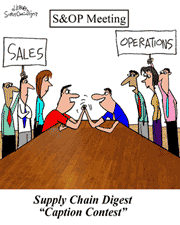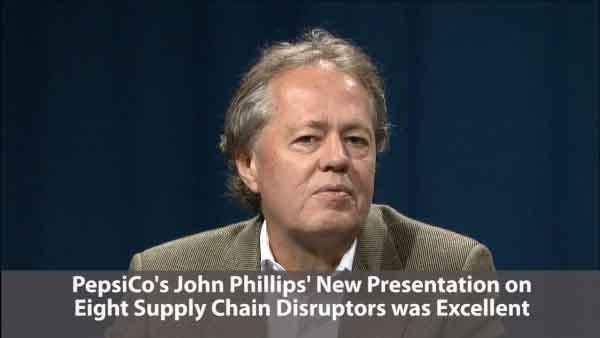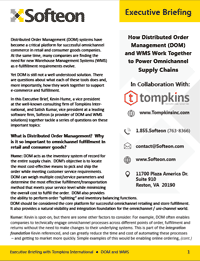Trip Report: Gartner Supply Chain Executive Conference 2017
Thankfully, I am now at the end of the Spring conference season, after numerous weeks on the road. It's actually hard work, since I attend virtually every session available, do daily video reviews, etc., but in the end it's really worth it because so many readers enjoy these summary reports.
This week, I was out West for the Gartner Supply Chain Executive Conference, as usual in Scottsdale, AZ.
You can find my Day 1 and Day 2 video reviews: Day 1 and Day 2. No one else is so crazy as I to script things out at the end of the day at these events, film my review wherever I can find a quiet spot, edit the video back in a hotel room later than night, etc.
| GILMORE SAYS: |
As he had done with the other presentations of his I had seen, Phillips provided some almost real-time updates as to the status of all of these technologies - very useful.
WHAT DO YOU SAY?
Send us your
Feedback here
|
As many know, the Gartner conference is rooted in the same basic event that was started by AMR Research back in the 1990s. After Gartner acquired AMR in 2009, Gartner infused additional organizational and marketing muscle into the conference, largely to the good. I am sure the event is now much more profitable for Gartner than it ever was for AMR.
There were more than 1900 attendees this year, up from 1500 a couple of year ago, and the event has an ever growing exhibitor and sponsor program. Gartner continues to get some marquee supply chain execs as speakers, though the event certainly has a much more of a "corporate" feel to it than it did in the more laid back AMR days.
A good percentage of the breakout sessions are sponsored by various technology or consulting vendors, and the price tag isn't cheap, north of $100,000 for a sponsor package that includes a presentation slot. But Gartner doesn't seem to have difficulty filling the sessions with sponsors.
All told there was certainly a lot of content presented. This week, I am going to focus on the keynotes, and will be back next week with highlights of some of the breakout sessions.
Garner analysis Debra Hofman and Michael Burkett kicked things off Monday a.m. with a wide-ranging presentation that was largely around digitization of the supply chain, a concept which is still somewhat vague to me, in that is it most often defined by a laundry list of technologies (IoT, advanced analytics, etc.) rather than a more overarching framework.
That said, the notion of building all this on some type of "digital platform" appears to be a growing imperative - though we are early in this technology game, it seems to me.
Hofman said the mission of the supply chain is increasingly about "new customer experiences delivered in socially and environmentally sustainable ways" - that is kind of interesting.
There was a lot of discussion of supply chain "ecosystems," which are collections of trading partners assembled to meet customer needs. Increasingly, Gartner says, the competition will be between ecosystems, not individual companies.
At one level, there is nothing really new about this thinking - we've been talking about competing supply chains for some two decades.
What is new, Gartner says, is the way these ecosystems will be digitally connected, and that increasingly connected products will also be part of the ecosystem as well.
Gartner also believes the relationships in these ecosystems will become primarily electronic, and not much based on human interaction, at least day to day. Supplier negotiations might soon be handled by smart software programs, for example.
What's more, the nature of many relationships will increasingly be short term or transitory, Gartner says, to meet the demand and supply needs of the moment.
Is this true? There some examples where it might play out that way - think of on-demand, short term warehouse space provider FLEXE, which makes available space in a market visible and reservable through its app. Will it work that way for direct material suppliers? Obviously not in many cases.
There was also a new twist in the "bimodal" supply chain model Gartner has been emphasizing for now three years. Mode 1 is the traditional supply chain, focused on cost, efficiency, service, etc. Mode 2 is all about innovation and new ways of thinking. Today, it is imperative companies pursue both Gartner says.
But implied in the past two years was that this meant setting up a separate organization for Mode 2, as indeed companies from chemical maker BASF to Walmart have done with various innovation labs.
But now Gartner says there must be just one organization, to eliminate the sense that the preponderance of supply chain managers are toiling away at the old boring stuff, while select others get to work on all the cool new ideas.
I understand that risk, but in practice, how do you really combine the two? Not said by Gartner, but the approach that makes sense to me is a rotation program across both groups, so all/most get to work on the cool stuff for a period of time.
Retired army major general Vincent Boles gave a pleasant enough talk on leadership, though as with others I have seen I think it is difficult to translate military supply chain issues and solutions to commercial ones.
But Boles said one thing I think is absolutely true: most attendees at the event will write down all kinds of good ideas from the conference that could be put into action, but when they get back to the office all that is soon forgotten - and wasted.
Why? People are busy, it's not the right time, we'll wait for next quarter, etc. Boles didn't use these words, but the axiom that the "perfect is the enemy of the good" applies here. It is better to take action soon, even if it's not perfect, was Boles' argument.
Wednesday began with an uninspired discussion with former Dallas Cowboys great Troy Aikman. It was entertaining in spots, but like most sports figures at these events it really added little value. I have seen very few really good ones, beyond just the celebrity factor.
Someone who certainly did add value was John Phillips, a supply chain executive at Pepsico. I have heard Phillips speak three times before, all on the need to synchronize the physical supply chain with the new digital world, and I was expecting an updated version of that. But no, while there was naturally a little overlap, Phillips presentation was about eight important supply chain disruptors.
It was to an extent mostly the usual cast off technology characters: the connected home, Iot in retail, in-store robotics, crowd-sourcing deliveries, drones, autonomous vehicles, virtual experts and artificial intelligence.
But as he had done with the other presentations of his I had seen, Phillips provided some almost real-time updates as to the status of all of these things - very useful - and also had a list of key considerations for each of the eight that was also useful - though I think all eight of them said something like start evaluating how you can use each of these technologies now.
As just one example, take the land-based drone from Starship Technologies, being use right now in both the US and Europe, that can deliver groceries or restraint meals in a robot that looks a little like R2D2, and has the possibility of reducing the cost of urban deliveries by 70-80%, as it navigates from some store to your apartment. Think how that might change the cost dynamics of last mile deliveries - and could this same technology used in factories or distribution centers, such as delivering needed supplies to a work cell? I say Yes.
All of these eight technologies are in real deployments somewhere in the world, Phillips says - time to get moving.
Kathy Wengel, head of supply chain for Johnson & Johnson, gave a solid presentation that might be summarized as dealing with supply chain complexity, though she started with the hopeful news that the human lifespan may extend to 140 years within a couple of decades.
I am almost out of space but Wengel noted how broadly J&J sources ideas, internally and externally (suppliers, academics), and has contests with prizes for the best ideas to solve a particular supply chain problem. The J&J supply chain also gave up on trying to eliminate SKUs the usual ways - long tail analysis, margin analysis, etc. Wengel said they realized they were just fighting too much upstream.
But it has had more success in standardizing so-called product platforms across the globe, meaning things like pack size and containers, labeling, etc. In the end, this also had the effect of reducing SKUs, but in a way that didn't feel like the supply chain was taking products away from sales, but rather helping the bottom line by reducing costs.
Good event again at Gartner this year. Part 2 of this Trip Report next week.
What is your reaction to Gilmore's Gartner Trip Report? Let us know your thoughts at the Feedback button below.
|



![]()
![]()

![]()
![]()










